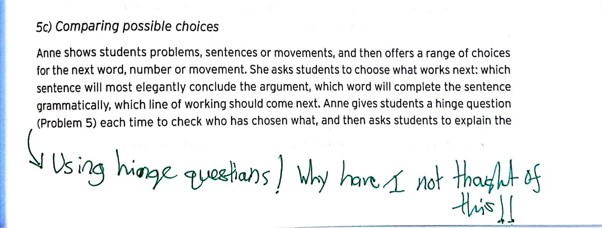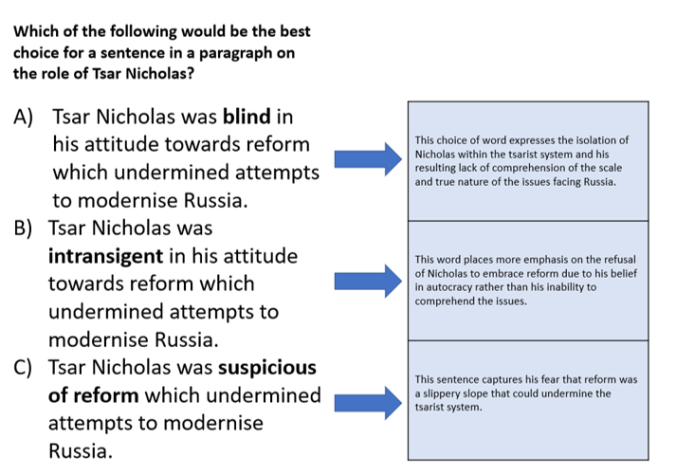I recently read Harry Fetcher-Wood’s excellent new book ‘Responsive Teaching’ and took away a wealth of insights, some of which I started trying to apply in the final weeks of the last school year. One of the central threads of the book is his championing systematic use of exit tickets and hinge questions. Daisy Christodoulou has also championed multiple-choice questions as a way of targeting student misconceptions and focusing student thinking on desired areas. Fletcher-Wood’s book introduced me to the idea that hinge questions could be used as a way of modelling essay writing which came as something of a revelation to me (as the scribbled annotation below captures). Like most good ideas it immediately seemed like something I should already have considered.

It seemed a powerful way of helping students to see writing essays as a series of choices and offered a wealth of possibilities in terms of targeting writing errors and misconceptions and use as a mode of feedback. I will now outline some of the ways in which I have started to apply this idea.
It is perhaps worth considering that live modelling writing with a class could achieve many of the same outcomes as the way I will advocate using hinge questions and can also allow for greater flexibility in modelling the writing process. However, I have found that the hinge question approach holds the following advantages over live modelling:
-It is more structured and can be designed around specific errors and misconceptions
-Hinge questions provide concrete alternatives and can illuminate misconceptions more effectively
This is still very much an embryonic technique for me but the two main ways that I have applied this idea so far are in targeting errors and in addressing word choice. They will also almost always be used in a lesson after a teacher has had a chance to read writing that students have produced and design the questions in response.
- Using hinge questions to target writing errors
This application applies hinge questions to writing in much the same way that they are conventionally used in targeting content misconceptions. After reading a class set of essays and completing a whole-class feedback sheet I might realise that my students are making the mistake of not making their argument clear in their opening sentence. I then construct a multiple-choice question targeting this issue, aiming for one opening sentence that is unambiguously the best and using the other answers as distractors that target the writing mistakes that my students are making at the start of a paragraph.
Example (red and green boxes explain my rationale for the choices and would not be visible to students)

The hinge question then gives me a good idea of which students made which mistakes, building on the diagnosis that I have made through my whole-class feedback resource and, crucially, opens up the issues to discussion and further questioning. As Paula Lobo-Worth argues here, the core purpose of these questions is as a discussion tool that targets a specific area. I might follow up the voting with questions like:
“Dylan, you chose D. Could you tell me what it was about choice C that you didn’t like as much?”
“Jack, why do you think that choice B is not a particularly good opening sentence?”
Once we have thoroughly unpacked the reasoning behind the choices and discussed each distractor in full I then ask students to write down the best option. We will then move onto the next section of the paragraph and follow the same process. Having gone through this process for a whole paragraph I will often ask students to complete a second paragraph or a whole essay, using the paragraph they have already written through multiple-choice questions to guide them. I find that this focuses their writing on the areas that I want them to improve in a more precise way than more general feedback processes like model answers.
- Using hinge questions to model word choice
I have always struggled to address word choice through my feedback to students. I have been guilty of giving plenty of feedback along the lines of ‘improve your word choice. Refer to my annotations’. I have sometimes written this kind of thing and attempted to address it with reference to model answers but I have rarely felt that this was sufficient either. The problem with this type of feedback, to paraphrase Dylan Wiliam, is that if they knew how to use words more precisely then they would already have done so! Hinge questions seemed to open up a way of stimulating reflection and modelling excellence here. This piece by James Carroll has been influential on my thinking in this area. His writing on the importance of blending the disciplinary and the substantive in the way that we support the writing of students has opened up the way I have approached this issue and I feel that a hinge question provides an ideal tool for supporting this kind of detailed sentence-level modelling.
Example (the blue boxes explain the reasons why I chose each word and would not be visible to students)
Essay question: Assess the seriousness of the problems facing Tsarist Russia before 1905 (exam-style essay)
Substantive focus: Russia 1894-1905
Disciplinary focus: The question contains elements of cause and consequence (what the reasons were behind the problems and the consequences the problems led to) as well as change and continuity (why Russia was unable to modernise quickly enough 1894-1905).

This question is then followed up with discussion of the merits of each of the choices, delving in to which of the choices best conveys the reasons that Nicholas failed to fully embrace reform. Both voting and discussing the choices afterwards therefore models the precision with which we want students to consider whether the words that they are using reflect the specific nature of the history they are writing about as well as the big ideas which are driving the essay as a whole.
This process can then be continued for a whole paragraph. If I decide to do this then I prefer keeping the questions in the format above and only making minimal changes to the sentence as a whole and focusing the choice and discussion on word choice as the targeted point of feedback. This format also has considerable potential in addressing the reductive way that students tend to write about sources and interpretations, particularly under the restrictions of exam questions. Paula Lobo-Worth’s use of multiple-choice questions in relation to sources provides an excellent starting point.
I plan to explore and refine this tool further during the next academic year but I already feel that it has considerable potential in addressing some areas I had previously found problematic.
I really enjoyed the detail here David. I think it quite interesting how we’ve picked up the same lessons from Harry (I’ve only just read it, so haven’t had a chance to play around ‘in the field’ yet).
It is your introduction of different word choices that I particularly like. I have also wanted to make my students more cautious and reflective in choosing their adjectives. Your concrete way of doing so has given me a few ideas for September!
LikeLiked by 1 person
Great, I would love to know what you do with it! It would be good to have a chat about it at some point. Perhaps over coffee after another London history event.
LikeLiked by 1 person